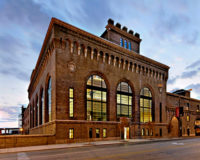Cannon Design
St. Louis, Missouri
' [Cannon Design Staff] are now living in a world where they can talk with each other and share ideas, and it makes our projects stronger and our team stronger.' ' Thomas Bergmann, Cannon Design
Architect Thomas Bergmann, managing principal of the Cannon Design St. Louis office, had walked past the Power House many times. The 1928 Revival-style building was a derelict landmark, listed on the National Register of Historic Places, just off the interstate — a sign of different and more prosperous times. The building began its life as a courthouse. Then the city turned it into a coal-fired power plant to heat about a dozen local buildings. In 1980 it was decommissioned.
It wasn’t until Bergmann’s firm was in the market for a new office that he saw the potential of the Power House. Even though it had been vacant for 30 years, “the light and the character and the feel of the space were very powerful to me,” says Bergmann. “It was a postindustrial cathedral.” And since Cannon Design’s lease was up on its office, it was the right time to leap. The firm analyzed the market and determined that if it utilized state, national, and Brownfield tax credits, purchasing the Power House from the developer/owner would make financial sense. So they bought it in 2007.
The subsequent renovation maintains the integrity of the original structure. To begin, the architects held an office-wide charrette that resulted in a “ship in a bottle” design. The interoffice team created a three-story gallery within the massive volume of the building. Then they inserted two separate floor plates that float above the ground floor to create extra balcony-like levels with meeting and work spaces. They also tucked the model shop, materials library, and boardroom in the basement and transformed an old storage structure into another boardroom and staff lunchroom. Ample open and flexible space allows approximately 120 employees
to work more collaboratively.
The project was completed in 2008 and awarded LEED Gold status one year later. More than 98 percent of the existing walls, floors, and roof structure were reused, and stormwater is collected in an on-site cistern, among other initiatives. The move proved wise. These days, the Power House is part of a block of municipal buildings that the city has recently invested in, says Bergmann. Besides Cannon Design, advertising and creative agencies are moving to the area. More important, clients are wowed when they visit — as is the staff. “Almost immediately, the productivity and employee happiness were ‘real,’ ” says Bergmann of the revived building’s effect on Cannon Design’s St. Louis team. “They are now living in a world where they can talk with each other, share ideas, and it makes our projects stronger — and our team stronger.”
Architect:
Cannon Design
1100 Clark Street
St. Louis, MO 63102
314.241.6250
314.241.2570
Location:
St. Louis, Missouri
Completion Date: August 2008
Total construction cost: $8 million
Gross square footage:
32,000 sq.ft.
PeopleOwner: Architect: Personnel in architect's firm who should receive special credit: Lynn S. Grossman, AIA, LEED AP Thomas C. Bergmann, AIA, LEED AP Kristy Piasecki, AIA, LEED AP J. Joe Scott, CPD, FASPE, LEED AP Ruofei Sun, Ph.D., PE, SE, LEED Gerald G. Williams, PE, LEED AP Architect of record: Cannon Design Interior designer: Cannon Design Electrical Engineer: Cannon Design General Contractor Consultants Environmental Services Photography Patti Gabriel Photography Renderings: Cannon Design CAD system, project management, or other software used: |
ProductsExteriors Flashing: Firestone Roofing: Mule Hide TPO Glazing Window Film/Solar Shading: Guardian Industries Doors Hardware Conveyance Lighting: Interior FInishes Casework: Ceilings: Paint/Coatings: Wall Coverings: Walls/Partitions: Fabrics/Textiles: Flooring (Hard-Surface/Resilient): Plumbing Electrical/Mechanical: Communications: Electrical/Electronics (Power/Wiring/Cabling): Fire/Life Safety: HVAC: |






















































































